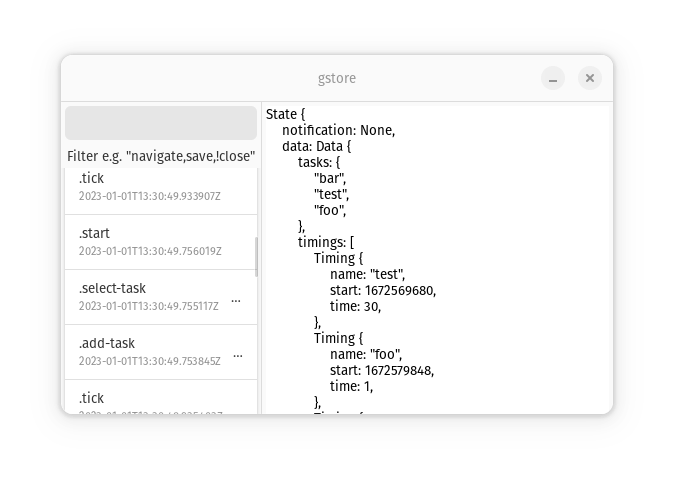29 releases (12 breaking)
| 0.12.0 | Apr 23, 2023 |
|---|---|
| 0.11.0 | Jan 1, 2023 |
| 0.10.3 | Dec 29, 2022 |
| 0.10.1 | Nov 6, 2022 |
| 0.5.1 | Mar 28, 2022 |
#807 in GUI
87 downloads per month
91KB
814 lines
Rust GTK App Framework
This libaray aims to provide a framework for adaptive GTK4 and libadwaita apps written in Rust.
Writing flatpak apps requires several files (.desktop file, appdata.xml, flatpak manifest). gtk-rust-app and its CLI gra allow to generate these files based on an extended Cargo.toml.
Getting started TLDR
cargo install cargo-generate
cargo generate --git https://gitlab.com/floers/gtk-rust-app-template
cd <your app>
sudo make install-gsettings
cargo run
Getting started
Creating apps with gtk-rust-app requires to
- Add more metadata to the Cargo.toml
- Write some boilerplate code in main.rs
- Define App pages
- Optional: Define a build.rs script
- Install cargo-gra subcommand
- Install app settings locally
Cargo.toml
Define app metadata and the dependency to gtk-rust-app in your Cargo.toml. Checkout the manifest reference for more info.
# Cargo.toml
[package]
...
[app]
# Metadata of your app
[settings]
# global settings
[actions]
# global GTK actions
[dependencies]
# as usual
gtk-rust-app = { git = "https://gitlab.com/floers/gtk-rust-app.git", features = [ "ui" ] }
# If you want to automatically update generated files you can add this build dependency
[build-dependencies]
cargo-gra = "0.3"
App boilerplate code
Create the file main.rs:
// src/main.rs
#[macro_use]
extern crate gtk_rust_app;
#[macro_use]
extern crate log;
use gettextrs::gettext;
use gtk::prelude::*;
use gtk_rust_app::widgets::LeafletLayout;
use crate::home::Home;
// This module will contain our home page
mod card;
mod home;
fn main() {
env_logger::init();
info!("{}", gettext("Check po/ dir for translations."));
// call app builder with metadata from your Cargo.toml and the gresource file compiled by the `gtk_rust_app::build` script (see below).
gtk_rust_app::builder::builder(
include_bytes!("../Cargo.toml"),
include_bytes!("../target/gra-gen/compiled.gresource"),
)
// include your style sheets here
.styles(include_str!("styles.css"))
.build(
|application, _project_descriptor, settings| {
// setup custom types
card::Card::static_type();
// The pages will be placed in this predefined adaptive layout.
let leaflet_layout = LeafletLayout::builder(settings)
.add_page(Home::new())
.build();
// LeafletLayout contains a toast overlay
leaflet_layout.show_message("Hello world");
// and we use the leaflet layout as root content in the apps window.
let window = gtk_rust_app::window(
application,
gettext("Example"),
settings,
leaflet_layout.upcast_ref(),
);
window.show();
},
|app, _project_descriptor, _settings| {
if let Some(action) = app.lookup_action("quit") {
let simple_action: gdk4::gio::SimpleAction = action.downcast().unwrap();
simple_action.connect_activate(glib::clone!(@weak app => move |_, _| {
app.quit();
}));
}
},
);
}
Define app pages
The home page:
//src/home.rs
use gdk4::subclass::prelude::ObjectSubclassIsExt;
use gtk::prelude::*;
use gettextrs::gettext;
use crate::card::Card;
// Define a page of your app as a new widget
#[widget(gtk::Box)]
#[template(file = "home.ui")]
struct Home {
#[template_child]
pub card: TemplateChild<Card>,
}
impl Home {
pub fn constructed(&self) {
self.imp().card.connect_card_clicked(|card| {
println!("Text prop: {:?}", card.text());
});
}
pub fn new() -> Home {
glib::Object::new(&[]).expect("Failed to create Home")
}
}
impl gtk_rust_app::widgets::Page for Home {
fn name(&self) -> &'static str {
"home"
}
fn title_and_icon(&self) -> Option<(String, String)> {
Some((gettext("Home"), "go-home-symbolic".into()))
}
}
// home.ui
<?xml version="1.0" encoding="UTF-8"?>
<interface>
<template class="Home" parent="GtkBox">
<property name="hexpand">True</property>
<property name="vexpand">True</property>
<property name="orientation">vertical</property>
<style>
<class name="home" />
</style>
<child>
<object class="Card" id="card"></object>
</child>
</template>
</interface>
Write your custom widgets
The examples above mention a card module. You can come up with your own idea (it works like the home page) or look into examples/simple/src/card.rs.
Optional: Build script
Define the build script:
// build.rs
pub fn main() {
println!("cargo:rerun-if-changed=build.rs");
println!("cargo:rerun-if-changed=Cargo.toml");
println!("cargo:rerun-if-changed=src");
println!("cargo:rerun-if-changed=assets");
println!("cargo:rerun-if-changed=po");
gra::build(None, None);
}
Install cargo-gra
cargo install cargo-gra
Prepare the app build via:
cargo gra gen
and build it as usual:
cargo build --release
You can build a flatpak app via:
cargo gra flatpak
That's it.
Install app settings locally
GTK apps define their settings and need gnome or phosh to have these settings installed globally. When you want to run your app without having these settings installed it will crash with an error.
Add the following Makefile to your project:
install-gsettings:
install -D target/gra-gen/{{app-id}}.gschema.xml /usr/share/glib-2.0/schemas/{{app-id}}.gschema.xml
glib-compile-schemas /usr/share/glib-2.0/schemas
uninstall-gsettings:
rm /usr/share/glib-2.0/schemas/{{app-id}}.gschema.xml
glib-compile-schemas /usr/share/glib-2.0/schemas
And replace {{app-id}} with your app id. Then run make install-gsettings and your app should run fine.
Run with different language
LANGUAGE="de_DE:de" LANG="de_DE.utf8" TEXT_DOMAIN="target" cargo run
Requirements
Debian dependencies:
sudo apt install libgraphene-1.0-dev libgtk-4-dev flatpak-builder
Arch dependencies:
TODO
To build a flatpak you need the to install gnome-nightly remote. Download https://nightly.gnome.org/gnome-nightly.flatpakrepo.
flatpak remote-add --if-not-exists gnome-nightly gnome-nightly.flatpakrepo
flatpak install org.gnome.Sdk//master
flatpak install org.gnome.Platform//master
flatpak install org.freedesktop.Sdk.Extension.rust-stable//21.08
Examples
Checkout the example apps in carg-gra.
Writing custom Widgets
The example above already showed a custom GTK widget. The #[widget] macro makes it easy and fast to create custom widgets but it abstracts and simplifies some aspects. The GTK Rust book is a good source to understand what the #[widget] macro does and how to create custom widgets with full control.
https://gtk-rs.org/gtk4-rs/stable/latest/book/introduction.html
Domain model and GObjects
Sometimes we need GObjects. Widgets are special GObjects. Similar to the #[widget] macro gtk-rust-app allows to define GObejcts quickly with the #[gobject] macro. An Example:
We have a domain struct TodoItem. Our application state stores these TodoItems in a vec and we want to select a single one in a GTK combobox (Or more likely in a AdwComboRow) menu. GTK expects a combobox to have a backing model which is a list of GObjects. Writing a GObject for our TodoItem is a lot of boilerplate code and we might not need the whole objectiveness because we are not writing object oriented code. Nevertheless we want our combobox to show the possible TodoItems and select one probably knowing the selected Id.
To address this problem gtk-rust-app provides the attribute macro gobjectify. The macro allows to define a set of fields for a struct which will be used to generate a GObject definition.
#[gobject(id, name)]
struct TodoItem {
id: String,
name: String,
text: String,
}
Will generate the GObject TodoItemGObject with the properties id and name and a public method TodoItem.gobjectify() -> TodoItemGObject.
gstore debugging
You can press Ctrl+Shift+G to open a debug window for the global state and actions implemented in gstore.
Note: This keybinding and window are only available dev builds.

Dependencies
~16–22MB
~251K SLoC